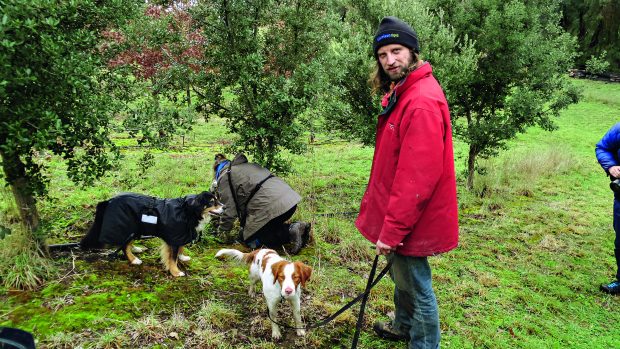Having a nose for truffles
By Adrian Utter (BAgrSc 2002)
The aroma is hard to describe. It’s pungent. Sweet. It has an element of fungus to it, like mushrooms. sometimes, you can smell the soil and you think it just smells like really good soil, but you have a dig around and you find a truffle.

Adrian Utter with dogs that help locate the truffles to determine when they are ripe. Picture: Karin McLean.
My interest in agriculture started from age four. I used to take cuttings of plants and propagate flowers to give to my family. I then started selling them at my Mum’s art workshops that she used to run on the family farm in Buxton. That love of plants just morphed into me wanting to pursue a career in agriculture or horticulture.
I enrolled in Agriculture at Melbourne Uni without necessarily knowing exactly where that would take me. I wanted to focus on plant production rather than animal production, particularly having spent a fair proportion of my younger years trying to be vegetarian.
At the time, my father started making wine and the process interested me. I studied plant production and viticulture. I studied subjects at different campuses and also lobbied strongly for plant subjects that weren’t necessarily going to be run as the focus was shifting towards animal production.
I went to Tasmania for work and one of my colleagues was talking with a nutritionist about truffles and it got me thinking. It was a completely different challenge to standard horticulture. In mainstream horticulture, we are trying to keep funghi away. We’re trying to grow a plant where you can manipulate the yield and the harvest date so as to meet market specifications. Everything is very controllable and you’ve got the use of fertilisers and fungicides and insecticide to manage the crop.
With truffles, it’s a different kind of challenge and quite opposite to what I do in my day job managing different horticultural crops for a family-owned company. I look after viticulture in my local region but also cherries, olives and a bit of citrus.
One of the challenges I find with truffles is that chefs are often asking how the truffle season will go and how much you are going to produce. But everything is underground. You don’t know how much is there because you can’t see it. You don’t know when it’s ripe because it can be there and present but it ripens in a very short, distinct period and you have to rely on your own nose – and your dog’s nose – to determine when the truffle is ready for harvest.
We planted the truffles in the winter of 2008, just before the February 2009 bushfires. We were very lucky compared to many neighbours, but it burnt through the truffle patch and I wonder if that did something to start producing the truffles earlier. We found our first truffle when the trees had been in the ground for three to four years.
A truffle is an ectomycorrhizal funghi. It lives as a sheath on the outside of the tree root in a symbiotic relationship. The mycelium of the truffle fungus grows through the soil and is able to mineralise fixed phosphorus, making it available for the tree’s growth. In return, the tree provides carbohydrate as an energy source for the fungus.
You need to train your dog to identify that aroma and then mark where that aroma is coming from. Then you get down and smell whether the truffle is ripe. It is a unique experience working with the dog and quite fun to have to have that interaction with the animal.
Selling the truffles has been a little bit harder than people expect. It is a gourmet product and the market is fairly small in Australia. _ e awareness of truffle is high but a lot of people think that it is priced out of their reach. But if people understood the small amount they needed to cook with and what it could do, they wouldn’t think it is priced particularly high.
The main thing a truffle does for a meal is really enhance the aroma of the food. It can be quite difficult to cook with truffle because you don’t want to heat the truffle too much. I love it with scrambled eggs, partly because you can infuse the egg with the aroma before you cook it. I love it in simple dishes. Potato and truffle together are beautiful. You want to preserve those aromatics.
With Karin McLean.



